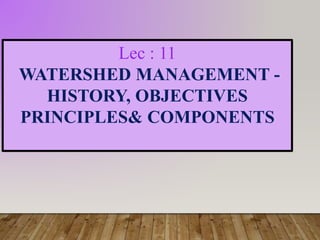
watershed_concept_obj-Lec-No.-11-1-converted.pptx
- 1. Lec : 11 WATERSHED MANAGEMENT - HISTORY, OBJECTIVES PRINCIPLES& COMPONENTS
- 2. 11.1 Concept of watershed management A watershed is defined as any spatial area from which runoff from precipitation is collected and drained through a common point or outlet. In other words, it is a land surface bounded by a divide, which contributes runoff to a common point.
- 3. Watershed is defined as a geohydrological unit draining to a common point by a system of drains. All lands on earth are part of one watershed or other. Watershed is the land and water area, which contributes runoff to a common point.
- 5. Watershed management implies the use of soil and water resources within a given geographical area so as to enable sustainable production and to minimize floods. Watershed management is the rational utilization of land and water resources for optimum production with minimum hazard to natural resources.
- 6. 11.2 Watersheds classified depending upon the size, drainage, shape and land use pattern. Macro watershed (> 50,000 Ha) Sub-watershed (10,000 to 50,000 Ha) Milli-watershed (1000 to10000 Ha) Micro watershed (100 to 1000 Ha) Mini watershed (1-100 Ha)
- 7. 11.3 History of watershed management: Watershed management has been taken up under different programs launched by Government of India. In 1962 – RVP (Soil conservation work in catchments of river valley projects) was established. In 1977-78- ministry of rural development started programme “ DDP- Desert Development Programme” for hot areas like Rajasthan, Haryana, J&K. In 1980- ministry of agriculture started a scheme- Integrated watershed management in catchments of flood prone rivers. In 1982- Water harvesting/ water conservation techniques in rainfed areas were started in 19 locations in India. In 1987 - The Drought Prone Area Development Programme (DPAP) and the Desert Development Programme (DDP) adopted watershed development approach. In 1989- The Integrated Watershed Development Project (IWDP) taken up by the National Wasteland Development Board (NWDB).
- 8. 11.4 Principles of watershed management Must Utilizing the land based on its capability Must Protecting the fertile top soil Minimizing the silting up of the reservoirs and lower fertile lands Insitu conservation of rain water Protecting vegetative cover throughout the year Safe diversion of surface runoff to storage structures through grassed water ways
- 9. Stabilization of gullies and construction of check dams for increasing ground water recharge. Increasing cropping intensity through inter and sequence cropping. It must be participatory, gender sensitive, realistic, integrated & productive, flexible & empowerment/ownership building
- 10. 11.5 Objectives of watershed management The term watershed management is synonymous with soil and water conservation with the difference that emphasis is on flood protection and sediment control besides maximizing crop production. The watershed aims ultimately at improving standards of living of common people in the basin by increasing their earning capacity, by offering facilities such as electricity, drinking water, irrigation water, freedom from fear of floods, drought etc.,
- 11. The objectives are To control Floods Adequate water supply for domestic, agricultural and industrial needs Reduction of organic, inorganic and soil pollution Efficient use of natural resources for improving agriculture and allied occupations so as to improve socio- economic conditions of the local residents and Expansion of recreation facilities such as picnic and camping sites.
- 12. The objectives of watershed management programme can also be described in symbolic form by the expression: POWER. Here the letters symbolize the following: P = Production of food-fodder-fuel-fruit-fibre-fish-milk combined on sustained basis - Pollution control - Prevention of floods O= Over exploitation of resources to be minimized by controlling excessive biotic interferences like over grazing - Operational practicability
- 13. W = Water storage - Wild animal and indigenous plant life conservation at selected places E = Erosion control - Ecosystem safety - Economic stability - Employment generation R = Recharge of ground water - Reduction of drought hazards - Reduction of siltation in multipurpose reservoirs - Recreation
- 14. 11.6 Action plan for watershed 1. Identification and selection of watershed: The boundary of the watershed has to be marked by field survey starting from the lowest point of the water course and proceeding upwards to the ridge line. The area may vary as low as 100 ha to as high as 10000 ha. 2. Description of watershed. Basic information has to be collected on Location Area, shape and slope Climate
- 15. Soil - geology, hydrology, physical, chemical and biological properties, erosion level Vegetation-native and cultivated species Land capability Present land use pattern Crop pattern, cropping system and management Farming system adopted Economics of farming Man power resource Socio economic data Infrastructural and institutional facilities
- 16. 3. Analysis of problems and identification of available solutions 4. Designing the technology components a. Soil and moisture conservation measures b. Run off collection, storage and recycling c. Optimal land use and cropping system d. Alternate land use system and farming system e. Other land treatment measures f. Development of livestock and other allied activities g. Ground water recharge and augmentation
- 17. 5.Preparation of base maps of watershed incorporating all features of geology, hydrology, physiography, soil and proposed development measures for each part of watershed. 6. Cost-benefit analysis to indicate estimated cost of each component activity, total cost of project and expected benefit. 7.Fixing the time frame to show time of start, duration of project, time frame for completion of each component activity along with the department / agency to be involved in each component activity 8.Monitoring and evaluation to assess the progress of the project and to suggest modification if any
- 18. 9.On-farm research to identify solutions for site-specific problems. 10. Organizational requirement include Water shed development agency with multidisciplinary staff Training to personnel Training to farmers Credit institution Farmers forum /village association Non governmental organization
- 19. THANK YOU